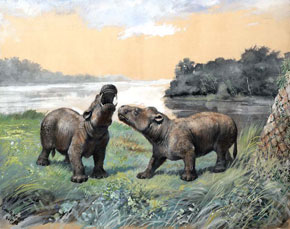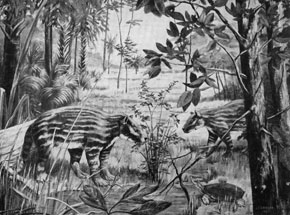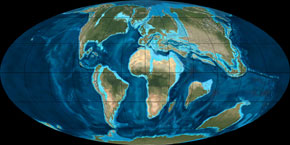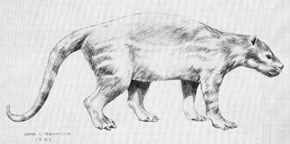Interval 0
Interval 0 – After the Dinosaurs: 65 MYA to 55 MYA
The extinction of the non-avian dinosaurs 65.5 million years ago marked the beginning of a new geological era, the Cenozoic. We are still living in the Cenozoic, but the Earth 65 million years ago was very different to the world of today. The continents were beginning to drift into their present day positions; in both the Northern and Southern Hemisphere, the remains of the ancient super-continents of Laurasia and Gondwanaland were pulling apart into the familiar landmasses that we see today. The planet was much warmer than today – there were no polar icecaps, and land at high latitudes was covered with thick forests of coniferous and deciduous trees. Closer to the equator, these were replaced by sub-tropical and tropical rainforests. With no large grazing dinosaurs to thin them, these forests were probably much denser than those of the Cretaceous.
Living in these forests were the survivors of the mass extinction that had ended the Cretaceous, which included many species of mammal. The first mammals had appeared during the Triassic, over 140 million years earlier, but were mostly small animals occupying a limited number of ecological niches. During first 10 million years of the Cenozoic, a geological epoch known as the Paleocene, these small survivors diversified into rodent-like mammals, medium sized mammals scavenging in forests, and large herbivorous and carnivorous mammals hunting other mammals, birds, and reptiles. Most of the Paleocene mammals belonged to primitive (or archaic) groups; the familiar groups of modern mammals – including the perissodactyls – did not appear until the Eocene epoch, which began 55 million years ago.
During the Paleocene the Earth was gradually getting warmer and more humid. Around 56 million years ago, this gradual warming reached a tilt point. In the deep sea, temperatures had risen enough to cause the melting of clathrates, deposits containing billions of tons of trapped greenhouse gasses. When these were released into the atmosphere, the temperature of the globe began to rise much more quickly.


Left: Reconstruction of the archaic herbivorous mammal Coryphodon by the artist Charles Knight. Wikimedia Creative Commons. Right: Reconstruction of the archaic herbivorous mammal, Ectoconus in a typical Paleocene habitat. John Germann\AMNH.


